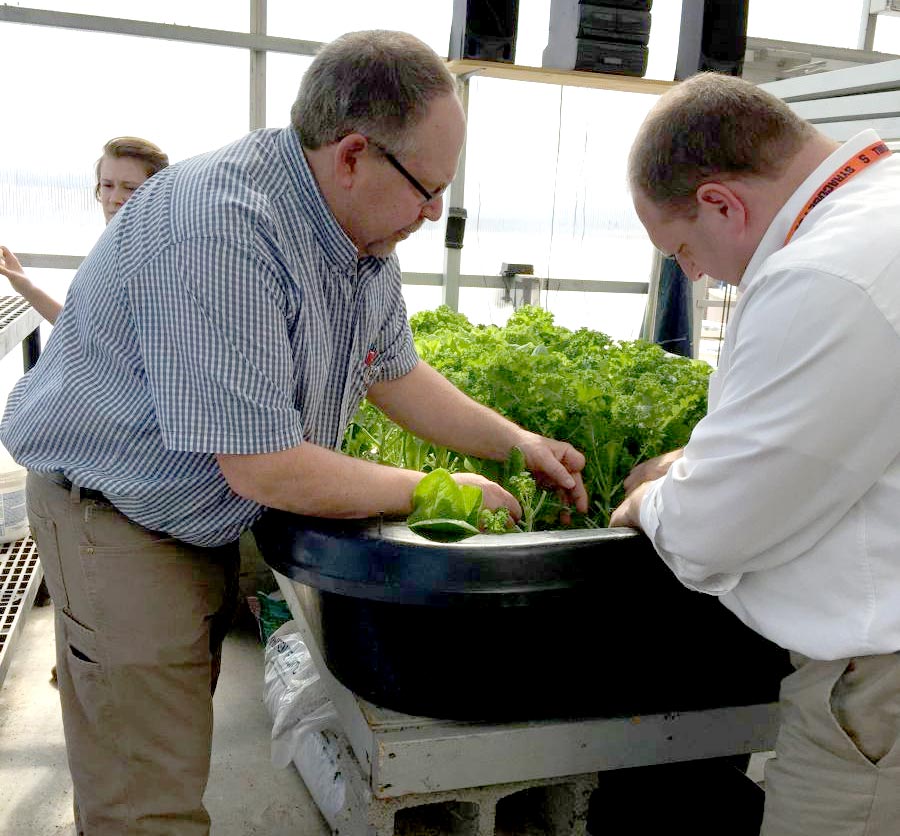
Photo Caption: Bruce Rohr, left, and Mike Comet tend to the hydroponic growth of Boston Bibb lettuce and kale in a state-of-the-art greenhouse at South Lewis High School. The facility was built, furnished and stocked at no cost to the district, thanks to grants the two teachers secured from a variety of sources.
Ever since an environmental science teacher and an agriculture teacher began their professional collaboration in 1993, things have been, well, blossoming at South Lewis School in the North Country’s Lewis County.
Meet Mike Comet and Bruce Rohr, both members of the South Lewis Teachers Association. They grow crops aquaponically, hydroponically and traditionally; they teach aquaculture, breed fish, compost waste, build greenhouses and repurpose old appliances, like turning a washing machine into an apple cider mill, for instance.
And when their school garden turns out a bumper crop of cabbage, as it did last fall, they take the surplus and turn it into a teachable moment by showing their students how to make sauerkraut.
“We did it more as an opportunity for experience for our kids than as a designated lesson,” said Comet, who teaches living environment and was a runner-up for 2015’s New York State Teacher of the Year award. “It might not be in the curriculum, but it will certainly get them engaged and thinking about the importance of our food supply.”
All that cabbage is on a long list of produce grown in the “Falcon Food Plot,” a nearby garden named for the school’s mascot, that delivers a variety of vegetables for use in the school cafeteria and for distribution to a local food bank and to school staff.
The garden was created with some real “seed money” – a few local grants Rohr received, plus a multiyear grant from the U.S Department of Agriculture. Grants also helped the two colleagues build a massive 3,000-cubic-foot compost facility that recycles cafeteria waste and schoolyard clippings into fertilizer for the Falcon food plot and school flowerbeds.
Their flair for grantsmanship has led them down what Comet modestly describes as “a rather prosperous road.” That road led them to grants that enabled them to build the school a 1,200-square-foot greenhouse that is automated and outfitted with hydroponic and aquaponic growing facilities.
The greenhouse, by the way, is also home to the brook trout that are released annually into local streams through Trout in the Classroom – a grant-funded program underwritten by Trout Unlimited.
“We always joke that Bruce is the idea man and I can just type quickly and have the gift of gab,” Comet said, in explaining the duo’s success in finding funding.
Nevertheless, the bottom line is that in most years their grant awards have exceeded their district-supplied budget. “They have put us in the driver’s seat of many of our projects, for sure,” said Comet, who serves as vice president of the South Lewis TA.
More importantly, those grants provide the materials, facilities and equipment that deliver benefits and learning opportunities the students might not otherwise receive at this small high school in a sparsely populated, far-from-affluent, rural region of the state.
Over the years, Rohr noted, the program’s graduates have achieved success in every possible field of agriscience, from veterinarians to groomers to agriculture educators to those working on – and often taking over – family farms.
But the program that utilized the equipment that brought those graduates such success was designed and continually improved by the two teachers, often brainstorming new ideas as they carpooled to and from school.
Rohr and Comet were busy expanding the scope of the agriculture program at South Lewis – developing, tweaking and aligning the curriculum for new and challenging classes – nearly a decade before the State Education Department in 2001 began restructuring traditional high school vocational coursework into the more academically challenging Career and Technical Education program.
Like the South Lewis teachers, the Board of Regents has continued to blur the line between CTE and traditional academic coursework.
In January, the state board gave final approval to a NYSUT recommendation that high school students be allowed to substitute a passing score on an approved CTE exam or other alternative exam for one of the five Regents exams currently required for graduation.
It’s an encouraging move for the two educators, whose families remain close and whose children have grown up together. As for the professional camaraderie, “It’s been over 20 years,” Rohr said, “and it’s been nothing but a positive for the district -- and especially for the students.”
— John Strachan
(Mike Comet and Bruce Rohr are members of South Lewis Teachers Association)